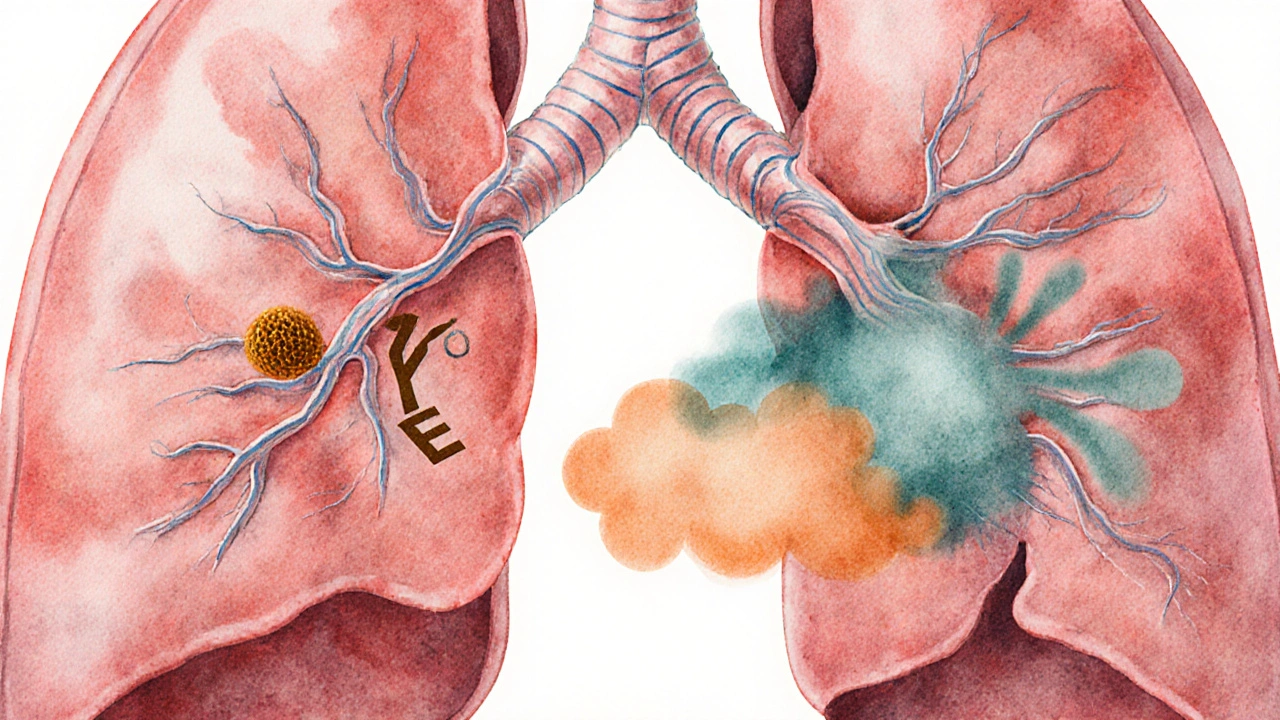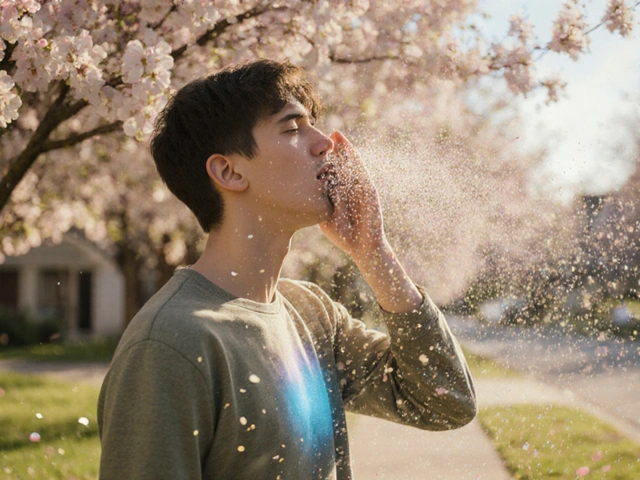Seasonal Allergies & Asthma Trigger Checker
Your Results:
Tree Pollen
Peak in early spring. Often the first asthma flare of the year.
Triggers AsthmaGrass Pollen
Peak in late spring to early summer. Especially affects outdoor exercisers.
Triggers AsthmaWeed Pollen
Peak in late summer to early fall. Major cause of fall asthma attacks.
Triggers AsthmaMold Spores
After rain, high humidity. Indoor and outdoor mold can provoke attacks.
Triggers AsthmaDust Mites
Year-round but spike in humid months. Often a hidden trigger.
Possible TriggerWhen pollen, mold spores, or ragweed start drifting through the air, many of us reach for a tissue or an antihistamine. But for a sizable group, that seasonal sniffle can quickly turn into wheezing, shortness of breath, and a night‑time cough. Understanding why allergic asthma often follows seasonal allergies is the first step toward breathing easier all year round.
Quick Takeaways
- Seasonal allergens can inflame the airways, making asthma symptoms flare.
- IgE antibodies, released during allergic reactions, are the main link between allergies and asthma.
- Common culprits include pollen, mold, and dust mites that peak in spring, summer, and fall.
- Early signs of allergic asthma include wheezing after exposure, nighttime coughing, and reduced exercise tolerance.
- Management combines allergy control (e.g., nasal steroids) with asthma therapy (e.g., inhaled corticosteroids).
What Exactly Are Seasonal Allergies?
Seasonal allergies are immune reactions that occur when the body encounters airborne allergens that are most prevalent during certain times of the year. Typical triggers are tree pollen in spring, grass pollen in early summer, and weed pollen in late summer and fall. Mold spores can also surge after rains, and they’re considered a seasonal allergen too.
Defining Asthma and Its Connection to Allergies
Asthma is a chronic respiratory condition marked by airway inflammation, hyper‑responsiveness, and reversible narrowing that leads to wheezing, coughing, and shortness of breath.
The bridge between the two conditions is the body’s immune system. When an allergen enters the nose or lungs, the immune system produces IgE antibodies. These antibodies attach to mast cells lining the airway walls. Upon re‑exposure, mast cells release histamine, leukotrienes, and other inflammatory mediators.
These chemicals cause inflammation of the airway lining, swelling of the nasal passages, and most importantly for asthma, bronchoconstriction-the tightening of the smooth muscle around the bronchi. The result is the classic asthma attack.
How Allergic Inflammation Turns Into Asthma Symptoms
Two key processes turn a harmless sneeze into a breathing problem:
- Airway hyper‑responsiveness: Repeated allergic inflammation makes the airway nerves hypersensitive. Even a small amount of pollen can cause the muscles to spasm.
- Mucus overproduction: Histamine triggers goblet cells to pump out thick mucus, which blocks the already narrowed airways.
Combined, these lead to wheezing, chest tightness, and a lingering cough-especially at night when the body’s natural cortisol levels dip.
Top Seasonal Allergens and Typical Asthma Triggers
| Allergen | Peak Season | Typical Asthma Trigger? |
|---|---|---|
| Tree pollen | Early spring | Yes - often the first asthma flare of the year |
| Grass pollen | Late spring-early summer | Yes - especially for outdoor exercisers |
| Weed pollen (ragweed, sagebrush) | Late summer-early fall | Yes - a major cause of fall asthma attacks |
| Mold spores | After rain, high humidity | Yes - indoor and outdoor mold can provoke attacks |
| Dust mite allergens | Year‑round but spikes in humid months | Often a hidden trigger for asthma sufferers |

Recognizing the Signs of Allergy‑Induced Asthma
Not every sneeze means an asthma attack, but these clues suggest the two are linked:
- Wheezing or whistling sounds that appear shortly after exposure to pollen or mold.
- Night‑time coughing that worsens during high‑allergen months.
- Shortness of breath during outdoor activities that improves indoors.
- Increased use of rescue inhalers when the seasons change.
If you notice a pattern, it’s worth discussing the possibility of allergic asthma with your provider.
Managing the Allergy‑Asthma Cycle
Effective control usually requires a two‑pronged approach: reducing allergen exposure and treating airway inflammation.
Allergen‑Avoidance Strategies
- Keep windows closed on high‑pollen days; use air conditioners with HEPA filters.
- Shower and change clothes after spending time outdoors to wash off pollen.
- Use a dehumidifier indoors to keep mold and dust mites at bay.
- Wash bedding weekly in hot water (130°F) to kill dust mite allergens.
Medication Options
Two medication families target the two sides of the problem:
- Inhaled corticosteroids (ICS)-the cornerstone of long‑term asthma control. They reduce airway inflammation, making the lungs less reactive to allergens.
- Antihistamines-help control nasal symptoms and can lower the overall allergic load, indirectly easing asthma.
- Leukotriene receptor antagonists (e.g., montelukast) block a specific inflammatory pathway that’s especially active in allergic asthma.
- For acute flare‑ups, short‑acting beta‑agonists (SABAs) like albuterol act as rescue inhalers to open the bronchi quickly.
For many patients, a combination of a low‑dose inhaled steroid plus a daily antihistamine provides enough control to stay out of the emergency room.
Immunotherapy: The Long‑Term Fix
Allergy shots (sub‑cutaneous immunotherapy) or sublingual tablets expose the body to tiny, gradually increasing amounts of allergen. Over months to years, the immune system builds tolerance, often reducing both allergy and asthma symptoms dramatically. Recent studies (2023‑2024) show a 30‑40% drop in severe asthma attacks among patients who complete a three‑year immunotherapy course.
When to Seek Professional Help
If any of the following occur, make an appointment promptly:
- Rescue inhaler use more than twice a week (excluding exercise‑induced episodes).
- Night‑time awakenings due to coughing or shortness of breath.
- Rapidly worsening wheeze that doesn’t improve with a standard rescue inhaler.
- Newly diagnosed seasonal allergies in someone who already has asthma.
Your doctor may perform spirometry, allergy skin testing, or blood‑type IgE measurements to confirm the link and tailor a treatment plan.
Everyday Lifestyle Tips to Keep Both Conditions in Check
- Track daily pollen counts using a reliable allergy app; plan outdoor activities for low‑count days.
- Maintain a regular exercise routine-moderate activity improves lung capacity, but always have a rescue inhaler on hand.
- Stay hydrated; thin mucus is easier to clear.
- Consider a plant‑free home during high‑pollen seasons; some indoor plants release pollen or mold spores.
- Vaccinate against influenza and COVID‑19-respiratory infections can amplify both allergy and asthma symptoms.
Key Takeaways
Seasonal allergens set off an immune cascade that inflames the airways, leading to asthma symptoms. By recognizing the pattern, reducing exposure, and using a mix of anti‑allergy and asthma medications, most people can keep the cycle under control. If symptoms persist or worsen, a healthcare professional can fine‑tune the regimen and consider long‑term options like immunotherapy.
Frequently Asked Questions
Can I develop asthma if I only have seasonal allergies?
Yes. Repeated allergic airway inflammation can lead to chronic changes that meet the clinical definition of asthma. Early management of allergies lowers this risk.
Do antihistamines help with asthma attacks?
Antihistamines relieve nasal and ocular allergy symptoms and can reduce overall allergen load, but they are not a substitute for inhaled asthma medication during an attack.
Is it safe to use a rescue inhaler every day during pollen season?
Frequent rescue inhaler use signals uncontrolled asthma. It’s a sign to step up controller therapy, such as adding or increasing an inhaled corticosteroid.
How long does allergy immunotherapy take to show benefits for asthma?
Most patients notice a reduction in symptoms after 6‑12 months, with maximal benefit typically reached after 3‑4 years of consistent treatment.
Can indoor air purifiers replace medication for allergic asthma?
Air purifiers improve indoor air quality and can lower allergen exposure, but they do not treat airway inflammation. Medication remains essential for most patients.



Leonard Greenhall
October 1 2025The post mixes immunology with marketing fluff, and the grammar is riddled with errors.
Abigail Brown
October 1 2025Seasonal allergies can feel like nature’s relentless audition for a drama, but there’s hope in every sneeze.
When you understand the immune choreography, you can turn the spotlight from despair to empowerment.
Remember, each pollen count is a cue for preparedness, not panic.
Stay curious and keep breathing easy.
Crystal Slininger
October 1 2025Let’s cut to the chase: the allergen‑immune axis is a covert operation, constantly feeding data to the mast cells.
What most readers overlook is the hidden agenda of the pharmaceutical lobby, pushing inhalers as the only solution.
Meanwhile, the real fix lies in desensitization protocols that re‑educate the immune system.
Ignorance is the price we pay for not questioning the dominant narrative.
Stay alert, stay skeptical.
Erin Devlin
October 1 2025Understanding the IgE‑mediated cascade helps pinpoint why symptoms flare.
It also guides targeted therapy choices.
Allison Marruffo
October 1 2025Great summary of the allergen triggers.
Keeping windows closed on high‑pollen days can make a noticeable difference.
Stay consistent with your prevention plan.
Ian Frith
October 1 2025When you pair an inhaled corticosteroid with an antihistamine, you’re attacking both the airway inflammation and the upstream allergic response.
This dual approach is often under‑utilized in primary care.
Patients who adopt it report fewer night‑time awakenings and reduced rescue inhaler use.
Don’t forget to re‑evaluate lung function after a season change.
Prevention is far more satisfying than constant crisis management.
Beauty & Nail Care dublin2
October 2 2025🔥 Wow, love the two‑pronged strategy!
It’s like giving your lungs a superhero cape!
Keep up the good vibes! 🔥
Oliver Harvey
October 2 2025Oh, look, another checklist of things you could have Googled yourself.
How original.
Raghav Narayan
October 2 2025Allergic asthma represents a classic example of how environmental antigens interface with the respiratory immune system.
First, pollen grains enter the nasal mucosa, where antigen‑presenting cells process them and migrate to regional lymph nodes.
There, naïve CD4+ T cells differentiate into Th2 cells under the influence of interleukin‑4.
These Th2 cells secrete cytokines such as IL‑5 and IL‑13, which promote eosinophil recruitment and mucus hypersecretion.
Eosinophils release major basic protein, damaging the epithelium and perpetuating inflammation.
Concurrently, B cells class‑switch to produce allergen‑specific IgE antibodies that bind to high‑affinity FcεRI receptors on mast cells.
Upon re‑exposure, cross‑linking of IgE triggers mast cell degranulation, releasing histamine, leukotrienes, and prostaglandins.
The latter compounds cause rapid bronchoconstriction, airway edema, and increased vascular permeability.
These acute changes manifest as wheezing, coughing, and shortness of breath, often worsening at night when endogenous cortisol is low.
Chronic exposure leads to airway remodeling, characterized by subepithelial fibrosis and smooth‑muscle hypertrophy.
This structural alteration reduces reversible airway caliber, making asthma more persistent.
Importantly, the seasonal pattern provides a predictable window for intervention.
Implementing environmental controls-such as HEPA filtration and limiting outdoor activity during peak pollen counts-can markedly reduce allergen load.
Pharmacologically, inhaled corticosteroids attenuate the underlying inflammation, while leukotriene receptor antagonists specifically block the downstream mediators of the allergic cascade.
For patients with severe disease, sub‑cutaneous immunotherapy offers a disease‑modifying approach by inducing regulatory T‑cells and shifting the immune response toward tolerance.
In practice, a personalized action plan combining avoidance, controller medication, and rescue inhaler availability yields the best outcomes.
Regular follow‑up with spirometry ensures that lung function is preserved and therapy is optimized.
Ultimately, recognizing the immunologic link between seasonal allergens and asthma empowers patients to break the cycle before it entrenches.
Tara Phillips
October 2 2025Excellent exposition, Dr. Narayan.
Your step‑by‑step breakdown clarifies the pathophysiology for clinicians and patients alike.
Implementing the recommended environmental controls can dramatically lower exacerbation rates.
Thank you for the thorough analysis.
Derrick Blount
October 2 2025Consider, however, that the epidemiological data suggest regional variations, which may affect the applicability of a universal protocol, and therefore, a nuanced, localized approach, is advisable, especially in areas with atypical pollen calendars.
Anna Graf
October 2 2025The article explains facts.
It is clear and simple.
Jarrod Benson
October 2 2025Yo, I’ve been battling ragweed attacks every fall, and let me tell you, the key is timing your runs right.
I start early before the pollen hits its peak, then I’m done before the sun’s high and the spores are everywhere.
Also, a quick shower right after a hike wipes off the pollen that clings to your hair and skin – otherwise you’re wheezing for hours.
Don’t forget a portable inhaler; it’s a lifesaver when the air feels thick.
And seriously, track the pollen index on your phone; it’s like a cheat code for breathing easy.
Liz .
October 2 2025Love the tips, man they’re super helpful thanks
tom tatomi
October 2 2025Everyone acts like pollen is the sole villain, but indoor dust is just as insidious.
Tom Haymes
October 2 2025You raise a valid point about indoor allergens.
Incorporating a regular vacuuming schedule with HEPA filters can keep dust mite exposure low.
Stay consistent, and you’ll notice fewer nighttime symptoms.
Brittany McGuigan
October 2 2025As an American, I must emphasize the importance of preserving our national health standards, which include stringent air quality regulations.
These measures protect our citizens from the invasive pollen that threatens our lungs.
We must remain vigilant.
Priya Vadivel
October 2 2025Thank you for the thorough overview; it’s reassuring to see a balanced approach to both prevention and treatment.
For readers who feel overwhelmed, remember that small, consistent steps-like using a dehumidifier and keeping rescue inhalers handy-can make a big difference.
Take care of your respiratory health.